Chapter 296-829 WAC
Last Update: 11/22/16HELICOPTERS USED AS LIFTING MACHINES
WAC Sections
| HTMLPDF | 296-829-099 | Definitions. |
| HTMLPDF | 296-829-100 | Scope. |
| HTMLPDF | 296-829-200 | Design and installation requirements for helicopters. |
| HTMLPDF | 296-829-20005 | Follow Federal Aviation Administration (FAA) requirements. |
| HTMLPDF | 296-829-20010 | Install and test hooks on helicopters correctly. |
| HTMLPDF | 296-829-300 | Maintenance. |
| HTMLPDF | 296-829-30005 | Keep landing and deposit areas safe. |
| HTMLPDF | 296-829-30010 | Follow safe refueling procedures. |
| HTMLPDF | 296-829-400 | Operating the helicopter. |
| HTMLPDF | 296-829-40005 | Hold daily briefings. |
| HTMLPDF | 296-829-40010 | Make sure employees are dressed correctly. |
| HTMLPDF | 296-829-40015 | Make sure loads are attached correctly. |
| HTMLPDF | 296-829-40020 | Make sure the load is handled correctly. |
DISPOSITION OF SECTIONS FORMERLY CODIFIED IN THIS TITLE
| 296-829-500 | Definitions. [Statutory Authority: RCW 49.17.010, 49.17.040, 49.17.050, and 49.17.060. WSR 04-09-099, § 296-829-500, filed 4/20/04, effective 9/1/04.] Repealed by WSR 14-09-095, filed 4/22/14, effective 7/1/14. Statutory Authority: RCW 49.17.010, 49.17.040, 49.17.050, 49.17.060, and chapter 49.17 RCW. |
PDF296-829-099
Definitions.
Aviation gasoline. Gasoline fuel for reciprocating piston engine helicopters, also known as avgas.
Cargo hook. A device attached to a helicopter that is used to hold suspended loads.
Competent person. One who is capable of identifying existing and predictable hazards in the surroundings, or working conditions which are unsanitary, hazardous, or dangerous to employees, and who has authorization to take prompt corrective measures to eliminate them.
Deadman controls. A control, switch or device that will automatically shut off whenever the operator releases it.
Deposit area. An area that is designated for dropping off and picking up suspended loads.
Downwash. The wind created by the rotating blades of a helicopter.
Ground device. A device used to dissipate the static electricity charge that has built up on a suspended load.
Helicopter crane. A helicopter that carries cargo or equipment suspended underneath it.
Jet B type fuel. A blend of gasoline and kerosene fuel.
Powered hoist. A powered device designed to lift and lower equipment and cargo.
Tag line. A line or rope used to control suspended loads that can swing freely.
PDF296-829-100
Scope.
Chapter 296-829 WAC applies to helicopters when used to carry loads, suspended with a cargo sling, powered hoist, or other attaching methods.
EXEMPTION: | This chapter does not apply to the use of helicopters: |
1. In the logging industry. | |
2. For rescue operations when a winch or hoist is used. |
PDF296-829-200
Design and installation requirements for helicopters.
Summary:
Your responsibility: To make sure your helicopters meet design specifications and are equipped properly.
You must meet the requirements... | in this section: |
Follow Federal Aviation Administration (FAA) requirements | WAC 296-829-20005 |
Install and test hooks on helicopters correctly | WAC 296-829-20010 |
PDF296-829-20005
Follow Federal Aviation Administration (FAA) requirements.
You must make sure helicopter cranes and their use meet the applicable requirements of the Federal Aviation Administration (FAA).
PDF296-829-20010
Install and test hooks on helicopters correctly.
(1) You must make sure electrically operated cargo hooks are:
(a) Designed and installed to prevent accidental operation.
(b) Equipped with an emergency mechanical control to release the load.
(2) You must make sure a competent person tests all hooks before each day's operation to make sure both the electrical and mechanical releases work properly.
PDF296-829-300
Maintenance.
Summary:
Your responsibility: To keep helicopters in safe operating condition.
You must meet the requirements... | in this section: |
Keep landing and deposit areas safe | WAC 296-829-30005 |
Follow safe refueling procedures | WAC 296-829-30010 |
PDF296-829-30005
Keep landing and deposit areas safe.
(1) You must make sure precautions are taken to prevent loose objects from being caught in the downwash and flying around. Secure or remove all loose gear:
(a) Within one hundred feet of lift and deposit areas.
(b) In all other areas affected by rotor downwash.
(2) You must make sure employees do not work under hovering craft, except where necessary to hook or unhook loads.
(3) You must make sure safe access and exit, including an emergency escape route, is provided for employees who hook or unhook loads.
(4) You must prohibit open fires in any area that could be affected by the rotor downwash.
(5) You must make sure unauthorized people do not go within fifty feet of the helicopter when the rotor blades are turning.
(6) You must make sure all employees:
(a) Stay in full view of the pilot, in a crouched position, when approaching or leaving a helicopter with rotating blades.
(b) Stay away from the area behind the cockpit or cabin unless the operator authorizes them to work there.
(7) You must take precautions to eliminate reduced visibility.
(8) You must make sure ground personnel take special care to stay clear of rotors when visibility is reduced by dust or other conditions.
PDF296-829-30010
Follow safe refueling procedures.
(1) You must make sure refueling areas are safe.
(a) Post "NO SMOKING" signs at all entrances to the refueling area.
(b) Provide at least one thirty-pound fire extinguisher, or a combination totaling thirty pounds, good for class A, B, and C fires, within one hundred feet on the upwind side of the refueling operation.
Reference: | For additional requirements relating to portable fire extinguishers, see WAC 296-800-300 in the safety and health core rules. |
(2) You must make sure workers involved in refueling are trained in both:
(a) The refueling operation; and
(b) The use of fire extinguishing equipment they may need.
(3) You must make sure the following precautions are taken before and during refueling:
(a) Keep unauthorized people at least fifty feet away from the refueling operation or equipment.
(b) Prohibit smoking and open flames within fifty feet of the refueling area or fueling equipment.
(c) Make sure helicopter engines are shut down before refueling, if using aviation gasoline or jet B type fuel.
(d) Pump fuel, either by hand or power.
(e) Use self-closing nozzles or deadman controls:
(i) Do not allow these to be blocked open.
(ii) Make sure nozzles are not dragged along the ground.
(iii) Make sure the helicopter and the fueling equipment are grounded.
(iv) Electrically bond the fueling nozzle to the helicopter.
(v) Do not use conductive hose for this bonding.
(f) Make sure all grounding and bonding connections are:
(i) Electrically and mechanically firm.
(ii) On clean unpainted metal parts.
(4) You must stop fueling immediately if there is a spill. Do not continue operation until the person in charge has determined it is safe.
PDF296-829-400
Operating the helicopter.
Summary:
Your responsibility: To make sure helicopters are operated safely.
You must meet the requirements... | in this section: |
Hold daily briefings | WAC 296-829-40005 |
Make sure employees are dressed correctly | WAC 296-829-40010 |
Make sure loads are attached correctly | WAC 296-829-40015 |
Make sure the load is handled correctly | WAC 296-829-40020 |
PDF296-829-40005
Hold daily briefings.
You must make sure the helicopter pilot and ground personnel hold a briefing before each day's operation to discuss cargo-handling plans.
PDF296-829-40010
Make sure employees are dressed correctly.
You must make sure employees receiving the load:
(1) Do not wear loose-fitting clothes that could snag on the hoist line.
(2) Wear personal protective equipment (PPE), including complete eye protection and hard hats that are secured by chin straps.
Reference: | For other requirements relating to PPE, see WAC 296-800-160 in the safety and health core rules. |
PDF296-829-40015
Make sure loads are attached correctly.
(1) You must make sure loads are properly slung so tag lines cannot be drawn up into rotors.
(2) You must make sure precautions are taken on all freely suspended loads to keep hand splices from spinning open or cable clamps from loosening, such as using pressed sleeves or swedged eyes.
(3) You must make sure the weight of the load does not exceed the manufacturer's load ratings.
(4) You must make sure hoist wires and other gear are not attached to or allowed to catch on any fixed structure.
EXEMPTION: | This requirement does not apply to pulling lines or conductors that "pay out" from a container or reel. |
PDF296-829-40020
Make sure the load is handled correctly.
(1) You must make sure signal systems, whether radio or hand signals, are checked before hoisting the load. When using hand signals, use those shown in Illustration 1.
(2) You must make sure workers on the ground do either of the following before touching the suspended load:
(a) Use a ground device to safely discharge any static charge; or
(b) Put on and wear rubber gloves.
(3) You must make sure there are enough employees for safe loading and unloading operations.
(4) You must make sure constant communications are maintained between the pilot and signal person.
(5) You must make sure the signal person is distinctly recognizable from other ground personnel.
helicopter hand signals
 | 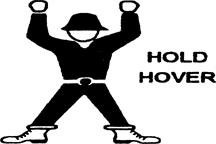 | |
Left arm extended horizontally; right arm sweeps upward to position over. | The signal "Hold" is executed by placing arms over head with clenched fists. | |
 | 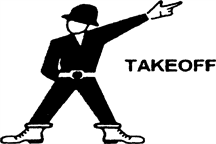 | |
Right arm extended horizontally; left sweeps upward to position over head. | Right hand behind back; left hand pointing up. | |
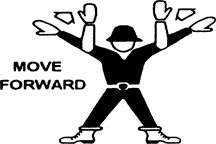 | 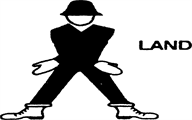 | |
Combination of arm and hand movement in a collecting motion pulling toward head. | Arms crossed in front of body and pointing downward. | |
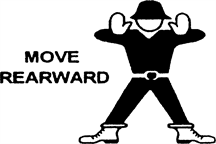 | 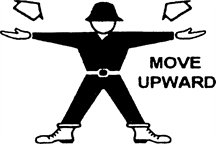 | |
Hands above arm, palms out using a noticeable showing motion. | Arms extended, palms up; arms sweeping up. | |
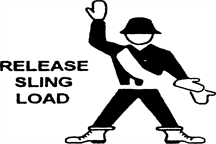 | 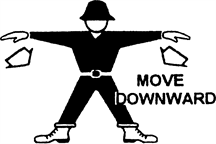 | |
Left arm held down away from body. Right arm cuts across left arm in a slashing movement from above. | Arms extended, palms down; arms sweeping down. |
[Statutory Authority: RCW 49.17.010, 49.17.040, 49.17.050, and 49.17.060. WSR 16-23-141, § 296-829-40020, filed 11/22/16, effective 12/23/16. Statutory Authority: RCW 49.17.010, 49.17.040, 49.17.050, 49.17.060, and chapter 49.17 RCW. WSR 14-09-095, § 296-829-40020, filed 4/22/14, effective 7/1/14. Statutory Authority: RCW 49.17.010, 49.17.040, 49.17.050, and 49.17.060. WSR 04-09-099, § 296-829-40020, filed 4/20/04, effective 9/1/04.]